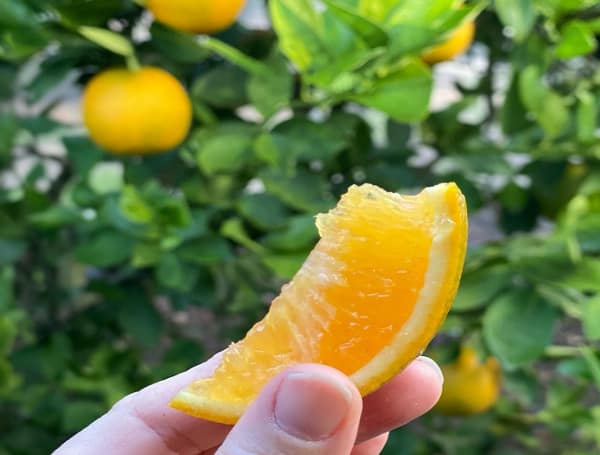The forecast of Florida’s orange production dropped again Wednesday, as efforts intensify to assist citrus growers who sustained damage in Hurricane Ian.
The U.S. Department of Agriculture issued a revised forecast that said Florida growers will fill 16 million 90-pound boxes of oranges during the current season. That is down from a January forecast of 18 million boxes and would be the lowest amount since 15.9 million boxes were filled in the 1935-1936 season.
The revised forecast did not change projections for grapefruit and specialty citrus fruits, which also could see the lowest production in decades.
In the news: Florida Ag Commissioner Wilton Simpson Wants To Move Quickly On Land Deals
Florida growers have reeled from Hurricane Ian, which hit in late September as the season was getting underway, and from a winter freeze. They also have struggled for two decades with deadly citrus greening disease.
Pointing to the issues facing the industry, Florida Citrus Mutual CEO Matt Joyner said in a statement Wednesday that “while the current crop size is a real disappointment, we’re not giving up.”
“Out in the groves, Florida’s citrus growers are seeing real, positive results from new treatments and therapies we’ve implemented this season to combat greening,” Joyner said. “We finally see a path forward, and our future has great promise.”
Mark Hudson, state statistician for the U.S. Department of Agriculture, said during a conference call that the non-Valencia orange crop is nearly complete, and the state has had a higher percentage drop in Valencia oranges than in January.
With the forecast for grapefruit at 1.5 million boxes and specialty crops at 500,000 boxes, the overall total would be the lowest since the 1927-1928 season.
In the news: Simpson Drops Florida Concealed Weapons Lawsuit
Even before Ian made landfall in Southwest Florida, the industry was forecast to see production reduced by one-third from the 2021-2022 growing season, which ended in July. September surveys found trees with smaller-sized fruit and fewer oranges per tree.
Last week, Gov. Ron DeSantis released a budget proposal for the 2023-2024 fiscal year that included $29 million for citrus protection and research. Lawmakers will consider the proposal as they negotiate a spending plan during the legislative session that will start March 7.
The current year’s budget, which went into effect July 1, included $37 million for the industry, with the biggest chunks of money being $17 million for Department of Citrus marketing programs, $8 million for research programs, and $6.2 million for what is known as the Citrus Health Response Program, which includes cultivating new trees resistant to greening.
Meanwhile, federal legislation filed last week by U.S. Sen. Rick Scott, R-Fla., U.S. Sen. Marco Rubio, R-Fla., U.S. Rep. Scott Franklin, R-Fla., and U.S. Rep. Debbie Wasserman Schultz, D-Fla., would establish a block-grant program in the Department of Agriculture to speed hurricane assistance to Florida growers.
Congress passed a $1.7 trillion omnibus spending bill in December that included $3.742 billion for crop and livestock losses across the nation in 2022.
In the news: Florida Citrus Budget Revised Amid Production Drop
Florida Citrus Mutual expressed concern that some Florida growers could be bypassed because the omnibus package didn’t include a block-grant program similar to one set up after Hurricane Irma damaged groves in 2017.
“The (newly proposed) Block Grant Assistance Act will enable Florida’s citrus growers to rebuild and replant so we can continue to harvest and produce America’s favorite breakfast juice,” Joyner said in a news release Monday.
In 2017, the Florida Division of Emergency Management received a $343 million federal block grant to distribute to growers.
The University of Florida Institute of Food and Agricultural Sciences estimated that Ian caused $1.07 billion in agricultural damages, including $247 million experienced by citrus growers.
The Florida Department of Citrus, pointing to larger losses because of the impact of Ian on trees, anticipates that $387 million to $635 million in federal relief is needed.
Android Users, Click Here To Download The Free Press App And Never Miss A Story. Follow Us On Facebook Here Or Twitter Here. Signup for our free newsletter by clicking here.
Latest News:
- Florida Woman Wins $1 Million Powerball Prize Matching All 5 White Powerball Numbers
- Boca Raton Man Killed When He Crashes Into Lakeland Police SUV
- Florida Gov. DeSantis “Freedom Is Here To Stay”
- Bomb Threat Stops Alex Murdaugh Trial, Courthouse Evacuated
- Florida Republican Proposes Consumer Loan Changes, Allowing Interest Rates Up To 36%
- Florida Gov. DeSantis Highlights Plan To Provide $2 Billion In Tax Relief For Florida Families
- Florida Teen Arrested For Shooting Death Of Another Teen At Local Fair
- Florida Senators Back ‘Live Local’ Housing Plan
- On Its 70th Birthday, Chevrolet Intros Electric AWD Corvette, 0-60 MPH In 2.5 Seconds
- VIDEO: Gronk, From The Super Bowl, Believes Tom Brady Coulda Played Till He’s 50
